Introduction: The Balance of Economics
Hello everyone, and welcome to our discussion on the intriguing concepts of disequilibrium and equilibrium in economics. Economics, at its core, is all about balance. It’s about understanding the forces that shape markets, prices, and the overall functioning of our economic systems. And at the heart of this balance lie the concepts of equilibrium and disequilibrium.
Equilibrium: The State of Balance
Equilibrium, in economic terms, refers to a state of balance. It’s a situation where the demand for a particular product or service matches its supply, resulting in a stable market. In this state, there is no inherent pressure for change. Prices are at a level where both buyers and sellers are content, and the market is in a state of rest. It’s like a perfectly still pond, undisturbed by any external forces.
Disequilibrium: The Catalyst for Change
On the other hand, disequilibrium is the state of imbalance. It’s a situation where the demand and supply of a product or service do not match, leading to market instability. In this state, there is a pressure for change. Prices may be too high, resulting in excess supply, or they may be too low, leading to excess demand. This imbalance creates a dynamic environment, where market forces are constantly at play, striving to restore equilibrium.

Causes of Disequilibrium
Disequilibrium can arise due to various factors. Changes in consumer preferences, technological advancements, government policies, or even natural disasters can disrupt the balance. For example, a sudden surge in demand for a product, without a corresponding increase in supply, can lead to a shortage, causing prices to rise. Similarly, a decrease in demand, without a reduction in supply, can result in a surplus, leading to price drops.
Implications of Disequilibrium
Disequilibrium, while disruptive, also presents opportunities. It acts as a signal, indicating the need for adjustments. For businesses, it can mean identifying untapped markets or areas of innovation. For policymakers, it can mean implementing measures to restore balance. However, if left unaddressed, disequilibrium can have long-term consequences. It can lead to market failures, economic inefficiencies, and even social unrest.
The Role of Equilibrium
Equilibrium, as the state of balance, is the ideal scenario. It represents a situation where resources are allocated efficiently, and markets function smoothly. It’s the point of stability, where the forces of demand and supply are in harmony. However, it’s important to note that equilibrium is not a static state. It’s a dynamic concept, constantly adapting to changing conditions. As such, achieving and maintaining equilibrium is an ongoing process.

